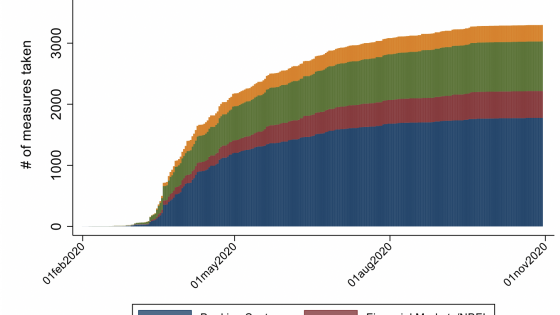The outbreak of the COVID-19 crisis triggered the adoption of extraordinary measures to support the economy and maintain the ability of banks to provide funds to the economy (ESRB 2021). The interventions have included a wide set of monetary, fiscal, regulatory, and supervisory measures for the banking sector (Feyen et al. 2020). The overall objective was to prevent a temporary shock having long-standing consequences for the economy.
As vaccines provide a light at the end of the tunnel, attention has increasingly turned to the phasing-out of these support measures, while avoiding cliff-edge effects. In a recent paper, prepared for the European Parliament’s Committee on Economic and Monetary Affairs (ECON), we discuss exit strategies from COVID-19 support programmes, focusing on Europe and specifically on regulatory and prudential measures, while underlining the close interlinkage with monetary and fiscal policy measures (Beck et al. 2021).1
Widespread and multi-pronged support for the real economy and banks
Monetary, fiscal, and regulatory authorities adopted a wide range of support policies and programmes in the spring of 2020. In the euro area, the ECB introduced a €1,850 billion Pandemic Emergency Purchase Programme of public and private sector assets (PEPP), enhanced its long-term refinancing operations, and kept key interest rates at historically low levels.
With regards to fiscal policy, the range of aid schemes has been wide across countries, including government-sponsored job retention programmes, grants to firms to compensate them for specific fixed costs such as rents or interest on loans, and income support for the self-employed. The overall government support packages related to the pandemic amount to about 14% of GDP in Europe based on information available up to September 2020 (ESRB 2021), while the reported uptake of these programmes was over €700 billion (roughly 4% of GDP), with more than €400 billion of loans with public guarantees and more than €840 billion of loans (around 5% of banks’ total loans) subject to loan moratoria.
With regards to regulatory and prudential policies, a number of policies aimed at releasing capital and liquidity, allowing enable banks to operate temporarily below the level of capital defined by the Pillar 2 Guidance (P2G), the capital conservation buffer (CCB), and the liquidity coverage ratio (LCR). Several national regulatory authorities also reduced countercyclical capital buffers (CCyBs) to zero. In return, banks were asked not to distribute profits in the form of dividends or share buy-backs and to be conservative in variable remuneration.
The combined effect of these measures was to create a virtuous circle between corporates, banks, and sovereigns, avoiding a funding crunch for either and keeping risk premiums at deflated levels. However, due to the higher debt level of governments and corporates, it also created the basis for possible increased systemic risk in the future. This reinforces the need for a carefully designed and coordinated exit strategy from the different support measures.
Keynes versus Schumpeter
On the one hand, support measures were put in place to help firms and households affected by the economic consequences of the public health shock. At the same time, continuous support can be justified with the attempt to avoid hysteresis – i.e. the risk that the current severe economic downturn and consequent high unemployment (in the absence of support measures) cause unemployed individuals to lose their job skills or become demotivated, resulting in high rates of long-term or structural unemployment. Such scarring effects would not only hamper economic recovery but ultimately result in lower longer-term growth rates. Supporting firms and people is thus the first priority – through such support, pressure on banks is also relieved.
On the other hand, the pandemic will have (possibly permanently) changed the returns on activity in different sectors and industries. There is thus a need for reallocation of resources within the economy post-pandemic. This requires a process of ‘creative destruction’, where some firms may have to undertake a profound transformation towards new products, services and/or markets, and new firms are created in sectors and industries with growth opportunities. Such a process would be impossible if support measures kept all firms in their current structure alive, irrespective of whether or not they are viable in their current structure in the long run.
At the core of this tension is uncertainty. Given the uncertain trajectory of the (exit from the) public health crisis, there is similar uncertainty about the necessary non-pharmaceutical interventions (NPIs) that will impact the economic recovery. On the one hand, this suggests maintaining the support for longer until the recovery process has clearly taken off, thus avoiding cliff-edge effects that can result in widespread insolvency and unemployment; on the other hand, it calls for a more differentiated approach in support going forward, focusing on sectors that are most affected by continuing NPIs and where persistence effects in consumption will imply a slower recovery process. Most importantly, however, it calls for erring on the side of maintaining support for too long rather than terminating it too early.
It is clear, however, that as we proceed towards an exit from the public health crisis, and thus towards broader-based economic recovery, the weights on the reallocation process become stronger than the weights on the survival/hysteresis arguments. This also implies that now is a good moment to properly prepare for such an exit strategy – critically, focusing on the inter-linkages between phasing out the different support measures and on institutional cooperation.
Returning to standard loan classification rules and remodulation of moratoria
In March 2020, loan loss classification standards were relaxed, with supervisors exercising flexibility regarding the classification of debtors as ‘unlikely to pay’ and the consequent specific provisions when such loans were subject to government-initiated interest payment moratoria. In addition, supervisors provided guidance to mitigate volatility in banks’ regulatory capital and financial statements stemming from IFRS9 accounting rules, which would result in excessive procyclicality of regulatory capital.
However, when banks are granted flexibility with regards to loan classifications, they may be induced to continue unviable relationships. Specifically, facing the risk of large losses if borrowers and loans have to be downgraded, banks have incentives to ‘evergreen’ loans – i.e. to roll over non-performing loans rather than recognising losses. The key question is how to achieve the right balance between supporting borrowers and setting appropriate incentives for banks. As the pandemic evolves and there is more visibility on the longer-term viability of borrowers, supervisory authorities need to ensure that banks provision adequately for loan losses on a forward-looking basis (Laeven et al. 2020), thus avoiding zombie lending (Bonfim et al. 2020). Re-establishing the preconditions for banks’ balance sheet transparency is also important to enhance their ability to raise private funds when ECB funding and liquidity support will be phased out. Restoring banks’ balance sheet transparency is thus a first-order objective to be undertaken early on, after the moratoria are phased out.
Exit from guarantees and corporate insolvency
Governments have provided guarantees for firms affected by the pandemic, with different maturities and conditions. While useful to support lending during the pandemic, the presence of guarantees may again encourage banks to lend to non-viable firms, with the risk of zombification.
As a consequence, policymakers should consider adjusting support policies by, for example, adding conditionality such as a business plan and financial projections that show that the borrowing firm is still viable, or maintaining support only for industries under prolonged confinement (e.g. the travel industry).
By the same token, the exit from guarantee schemes should be carefully designed. In fact, as argued by Gobbi et al. (2020), the collateral values are likely to fall when guarantees are lifted, potentially encouraging loan foreclosures. These considerations would call for a smooth phasing out of government credit guarantees to avoid cliff-edge effects on bank lending. At the same time, incentives for zombie lending and the associated risks of cliff-edge effects would be much reduced if firms were financed with equity instead of debt, also counteracting debt overhang. Therefore, the phasing out of credit guarantees could be usefully complemented with measures that promote the use of equity (or equity-like) instruments to reduce the excessive reliance on debt-based instruments (Laeven et al. 2020, Boot et al. 2020).
Return to ‘standard’ regulatory requirement and resolution planning
The broad support measures both by fiscal and regulatory authorities have paused the usual loss-recognition process. However, as these support measures are being phased out and as complementary supervisory actions (asset quality reviews and stress testing) are being undertaken, losses will emerge on banks’ balance sheets.
While this might not imply widespread bank failures, one can foresee a scenario where several banks are not only undercapitalised (relative to standard capital requirements, or at least under a stress scenario) but will not be able to raise additional capital on the market. The publication of the stress tests in the summer of 2021 will potentially trigger market reactions and might force supervisory reactions and will possibly require intervention by resolution authorities on the national or European level.
Authorities have to consider the possibility that the current framework will not be sufficient to address bank fragility, especially if bank failures are geographically concentrated. Close cooperation in scenario and contingency planning between supervisory and resolution authorities, as well as with the European Commission (given possible implications for state aid rules), is therefore called for. Such cooperation should take place on the national level (between national competent authorities, designated authorities, resolution authorities and – very relevant – deposit guarantee schemes). It should also take place on the European level, between the SSM and SRB, but also in cooperation with the European supervisory authorities, the European Systemic Risk Board and the European Commission.
Exit from capital relief and dividend restrictions
Capital relief and dividend restrictions are intended to preserve capital so that banks can better sustain lending to the economy until more visibility on the evolution of the pandemic and the effect on banks’ asset quality materialises.
Despite banks having made limited use of flexibility in terms of capital and liquidity requirements so far, a crucial question is when to ask them to rebuild capital buffers and over what period. Replenishing capital might require banks to raise fresh equity on the market; an undertaking which would be made more difficult by the current profit-distribution restrictions. It follows that, as much as there are arguments for combining capital relief and restrictions on profit distribution, there are strong arguments to phase them out in combination.
Conclusions
Designing proper exit strategy requires judgement as well as coordination among different national and international institutions. Whatever the exit strategy, it needs to be communicated in a clear and timely manner. This would provide banks with sufficient time and space to manoeuvre, and enable market participants (investors, market analysts, and rating agencies) to take action accordingly.
References
Beck, T, B Bruno and E Carletti (2021), “When and how to unwind COVID-support measures to the banking system?”, Requested by the ECON Committee of the European Parliament.
Boot, A, E Carletti, H-H Kotz, J-P Krahnen, L Pelizzon and M Subrahmanyam (2020), “Coronavirus and financial stability 4.0: Implementing a European Pandemic Equity Fund”, in A Benassy-Quere and B Weder di Mauro (eds), Europe in the time of COVID-19, CEPR Press.
Bonfim, D, G Cerqueiro, H Degryse and S Ongena (2020), “On-site inspecting zombie lending”, CEPR Discussion Paper No. 14754.
ESRB (2021), "Financial stability implications of support measures to protect the real economy from the COVID-19 pandemic".
Feyen, E, T Alonso Gispert, T Kliatskova and D S Mare (2020), “Taking stock of the financial sector policy response to COVID-19 around the world”, VoxEU.org, 17 December.
Gobbi, G, F Palazzo and A Segura (2020), “Unintended effects of loan guarantees during the Covid-19 crisis”, VoxEU.org, 15 April
Laeven, L, G Schepens, and I Schnabel (2020), “Zombification in Europe in times of pandemic”, VoxEU.org, 11 October.
Endnotes
1 The in-depth analysis is available on the European Parliament’s online database, ThinkTank. Copyright remains with the European Parliament at all times.






